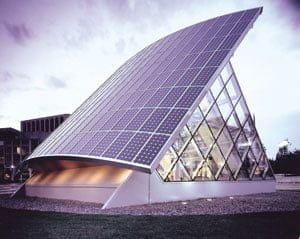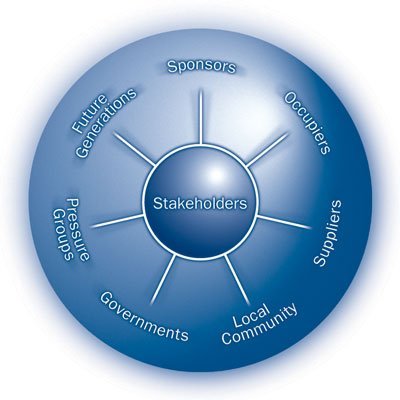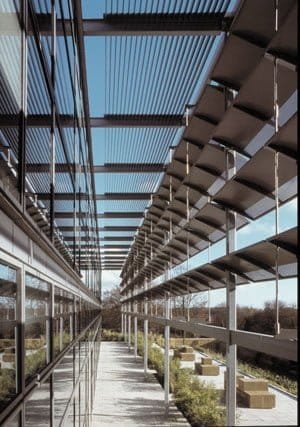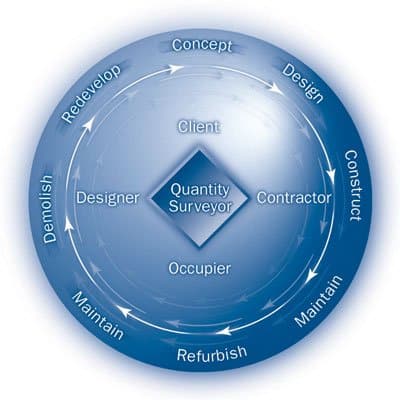
Many people perceive the construction industry as towering cranes over a city skyline or a pile of bricks and cement in a backyard. In fact the building work itself is only one phase in a development process known as the property lifecycle. Every house, school and road that is developed has its own property lifecycle, in which many different people are involved.
There are many factors that influence the property lifecycle. This study will focus on just one, the issue of sustainable development – development that meets the needs of the present without compromising the needs of future generations. The immense pressure on the world’s environment means measures must be taken today to safeguard natural resources for tomorrow. This is the challenge the construction industry faces.
Davis Langdon & Everest, EC Harris and Gardiner & Theobald are the world’s leading Quantity Surveying practices. The quantity surveyor is the key advisor at all stages of the property lifecycle. The role of the quantity surveyor includes:
- influencing key decisions relating to time, cost and quality
- managing construction finances and contracts
- influencing the design and construction process.
As international organisations with a global influence, Davis Langdon & Everest, EC Harris and Gardiner & Theobald are key players in the sustainable development arena. By putting aside their competitive differences, they are promoting sustainable development to ensure future generations can make key choices about the environment in which they want to live.
Impacts on the environment
The greenhouse effect is caused by trace gases in the atmosphere. Emissions of CO2 are alone responsible for 50% of the global warming effect, resulting mainly from energy used in buildings – heating, lighting and air conditioning. As energy is readily available today at a relatively low cost, it is often taken for granted. Consequently many people fail to think about energy conservation.
Depletion of the ozone layer is mainly due to the use of CFCs which react with the ozone in sunlight. Approximately 10% of the UK’s annual use of CFCs is related to buildings, in refrigerants and foam insulation used in building fabrics. Buildings are created with the aim of providing better environments in which people can live, socialise and work.
Balancing stakeholder aspirations
Buildings, streets, neighbourhoods and districts make up the urban environment and should be functional as well as enhancing our social well-being. Clearly there is a limit to the availability of land and natural resources. Apart from the need to conserve other scarce and finite resources such as oil, coal and gas, the consumption of land and natural resources is in itself damaging.

As stakeholders in our environment, we must recognise that not only is the quality of the environment in which we live at stake, but also the future and continued existence of mankind. Stakeholders are individuals or groups with a direct interest in an organisation’s performance. The diagram shows the stakeholders surrounding the property lifecycle.
The quantity surveyor must take into account the shared expectations of these stakeholders. Concern for the environment has a high public profile as public opinion, pressure groups and government legislation and regulation continue to grow. This poses a threat to organisations who do not anticipate opportunities and future problems that may affect them.
The World Commission on Environmental Development published the report ‘Our Common Future’ in 1987. By the end of 1988, the report had received public support from over 50 nations, including the UK. As a result, the Earth Summit was held in Rio de Janeiro in 1992. The summit adopted Agenda 21, a comprehensive action plan, for the pursuit of sustainable construction into the next century. Agenda 21 called on national governments to set strategies for achieving sustainable development. This means acting nationally to have an impact globally.
In 1997, the United Kingdom and other industrial countries signed a treaty in Kyoto, Japan committing themselves to reducing the effects of greenhouse gas emissions to below 1990 levels. The UK government has also responded by introducing a series of initiatives.
A report carried out by Lord Rogers on behalf of the UK government tackles the problems of urban regeneration, recommending 60% of new housing should be built on land which has been developed previously. These sites are known as brownfield sites. According to this report, developments should:
- integrate with their surroundings
- optimise access to public transport
- use land efficiently and respect local traditions.
Sustainable construction

The construction industry is a major sector of the UK’s national economy and accounts for 7.5% of Gross Domestic Product. GDP is the sum total of a country’s output over the course of a year. In 1998 the construction industry’s output was £62 billion. As an industry, it employs in excess of 1.4 million people.
Macroeconomics describes the study of the whole economy and the interaction between constituent economic factors. A key macroeconomics objective is to make the most effective use of resources in order to encourage growth. A growing economy, however, is one that consumes more and growth comes with associated costs, such as depletion of the ozone layer, an increase in CFCs and the consumption of finite resources.
The construction industry has to meet the challenge of contributing to economic growth by continuing to provide new homes, offices and shops while improving the quality of both towns and countryside. Sustainable means lasting and enduring, therefore sustainable development is economic development that lasts. In construction, sustainability is of great importance because:
- 50% of material resources taken from nature are construction-related
- over 50% of national waste production comes from the construction sector
- 40% of energy consumption in Europe is construction-related.
The construction industry has developed a code of practice which has been adopted by all involved in the property lifecycle, demonstrating awareness of the sustainable agenda. Criteria within the code of practice states that the construction industry should not:
- cause unnecessary damage to the natural environment or consume a disproportionate amount of energy during construction, building use or disposal
- use materials from threatened species or environments
- endanger the health of occupants or any other parties.
In commissioning, constructing or operating buildings we should ensure that they:
- enhance living, working and leisure environments
- consume minimum energy over their lifecycle
- generate minimum waste over their lifecycle
- use renewable resources wherever possible.
It is now essential to reduce the environmental impact of CO2 emissions that result from constructing and running buildings. Buildings today cannot simply be constructed in isolation; thought must be given to the wider environment, the transport infrastructure and the local community.
Greater initial care and planning, more attention to the environmental impact of material and energy supplies and a more focused approach to the genuine needs of organisations and users must be the focus of quantity surveyors. Some of the available solutions, however, such as solar energy systems, are still very expensive and are therefore not widely used in buildings. What is required is a balance between environmental saving and capital cost. This is called the environmental equation.
Improving sustainability

The challenge to the property industry, owners and users is to produce buildings that are functional, flexible, require less energy to construct and consume less energy in their daily use. A 15% increase in initial building costs can result in a 5% per year saving in running costs. Over the life of the building these savings will far outweigh the increased initial cost.
In order to balance the economic equation of sustainability and affordability at a practical level, the quantity surveyor can follow what has been called the ‘Ten Commandments’ for sustainability in design and construction. They are:
- Re-use existing buildings – This reduces costs and the building is quicker to complete
- Design for minimum waste – Make designs simple with re-use in mind
- Aim for lean construction – Avoid over specification and use preassembly and repetitive components wherever possible
- Minimise energy in construction – Use minimum quantities and avoid energy intensive materials like aluminium and cement
- Minimise energy in use – Make best use of the natural environment. For example, open and close windows, rather than use air conditioning
- Don’t pollute – Dispose of waste and discharges sensibly. Make efficient use of the existing transport infrastructure
- Preserve and enhance biodiversity – Protect the natural habitat
- Conserve water resources – Recycle rain and waste water
- Respect people – Encourage community relations and public information. Look after staff with regard to Health and Safety
- Set targets – Targets should be set for the reduction of energy used, embodied energy, transport and waste. Setting targets is also a way of measuring achievements.
Utilising these ‘Ten Commandments’ goes a long way towards achieving sustainability in construction, but requires commitment from everyone involved. Even small savings in each area of the ten commandments can result in huge energy savings.
In all market sectors, most businesses now have an environmental policy. A company that builds for its own occupation will consider higher expenditure at the outset for lower energy bills tomorrow. Occupiers are now beginning to influence the initial specification of buildings by setting briefs that reflect the goal of sustainable development.
Sustainability in action – Wessex Water
Wessex Water’s new operations centre is currently under construction on a brownfield site in Bath. It will set new benchmark standards in the construction industry for environmental sustainability, leading to a new generation of green buildings. Wessex Water demonstrates a long-standing commitment to sustainability. Its approach to this building considers both the design and method of construction, together with the future operation of the building itself. The green agenda permeates this site and building at every level.
The building features a low-energy, naturally ventilated design and careful selection of materials to minimise environmental impact. For example, locally produced steel, concrete, quarried stone and re-cycled aggregates from the River Severn have been used. Lifecycle costing of alternative designs and materials also influenced major design decisions on the project. Surface water is stored and pumped around the site to serve various new water features and will also be used to flush toilets. All waste from the site is separated for recycling.
Wessex Water has been keen to assess the environmental benefits against their value for money. In striking the right balance between environmental benefits and increased costs, Wessex Water has found the services of an independent quantity surveyor vitally important.
The role of the quantity surveyor

The quantity surveyor is integral to the property lifecycle and can influence other sectors of the property and construction industry. All sectors of the industry, however, need to be committed to sustainable development if it is to be implemented successfully. The property industry as a whole needs to:
- increase awareness in social responsibility
- increase awareness in sustainable construction
- gain greater levels of commitment to the Ten Commandments
- continue to develop technology that can make currently expensive sustainable methods more economically viable
- be prepared to pay more now for less later
- aim for every development to be constructed using measured sustainable methods.
Davis Langdon & Everest, EC Harris and Gardiner & Theobald are committed to sustainable development. They are playing a key role in achieving sustainability in construction by:
- challenging existing building briefs and specifications
- aiming for standardisation of components
- endorsing techniques to demonstrate the benefits of paying more now for less later
- lifecycle costing
- making better use of Information Technology
- sponsoring research into running costs, design and construction time and motion studies
- ensuring better planning for waste management
- encouraging energy labelling of materials and components
- consulting more effectively with all parties involved.
A key element in this process is matching the procurement of materials to the objectives of stakeholders, such as occupiers who are concerned about the sustainability of the components that make up their property portfolio (the property supply chain). Driven by stakeholders, the quantity surveyor is increasingly managing the property lifecycle and the property supply chain to ensure that suppliers, manufacturers and designers meet the stakeholders’ sustainable objectives.
Conclusion

Sustainable construction is concerned with more than the fabric of the built environment. Buildings and the social, commercial and transport infrastructures around them must be constructed in ways that are sustainable in environmental and economic terms and add value to the quality of life for the individual and the community.
All sectors of the property lifecycle can make a contribution to achieving progress in all strands of sustainable development. There are many issues and challenges posed for all involved. The areas affected are many, including financial and regulatory measures, education and training, research and local action.
The quantity surveyor’s role is fundamental. Above all, buildings must be affordable and constructed at an economic cost which people are prepared to pay. Sustainable development is absolutely vital but must be balanced against longer term economic issues. These are the challenges faced by the quantity surveyor today in constructing our common future.
